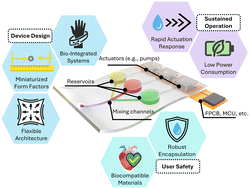An essential capability of lab-on-a-chip systems is the precise handling, management, and transport of fluids within microfluidic channels. However, conventional rigid pump-tube-valve systems are often incompatible with emerging wearable and implantable devices, which demand miniaturization, low power consumption, high level of integration, and biocompatibility to ensure reliable and safe operation in biological environments. In recent years, various microscale fluid management and transport strategies have been developed to address these challenges, enabling actively programmable control and significantly advancing the capabilities of bio-integrated electronics. This review summarizes key advances in design architectures, performance control, and integration strategies across four actuation modes: passive, mechanical, pressure-mediated, and electric field-driven mechanisms. Emphasis is placed on their respective advantages and limitations in key application scenarios such as sensing, drug delivery, and biofluid sampling. Finally, we outline potential future directions including device format, comfort level, user safety, and sustained operation, aiming to provide a strategic reference for the development of next-generation fluid management modules in soft bioelectronic systems.
